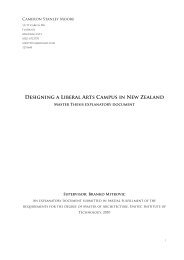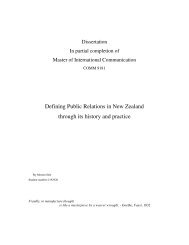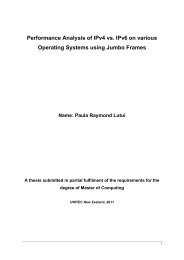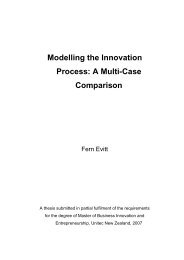The Study of Students Perceptions of On-campus ... - Research Bank
The Study of Students Perceptions of On-campus ... - Research Bank
The Study of Students Perceptions of On-campus ... - Research Bank
Create successful ePaper yourself
Turn your PDF publications into a flip-book with our unique Google optimized e-Paper software.
a maximum throughput <strong>of</strong> at least 100 Mb/s, as measured at the medium<br />
access control data services access point.” This was agreed by Thryft (2007)<br />
that depending on the design, an 802.11n network could reach a typical<br />
throughput <strong>of</strong> 144Mbps and a maximum throughput <strong>of</strong> 600Mbps. Of course,<br />
the 802.11n standard was not simply faster than any other 802.11 standards;<br />
the MIMO (multiple-input/multiple-output) technology and 40MHz channels<br />
made it more competitive. <strong>On</strong> the one hand, Abramowitz (2006) believed that<br />
the MIMO technology would improve wireless network performance by<br />
taking advantage <strong>of</strong> the multipath. <strong>The</strong> MIMO technology allowed multiple<br />
transmissions received by multiple receivers at almost the same time which<br />
construct the multipath, and this multipath was the reason why 802.11n<br />
could provide higher throughput and better reconstruct weak signals<br />
(Abramowitz, 2006). <strong>On</strong> the other hand, Garcia (2007) pointed out that the<br />
802.11n technology could operate in two frequencies <strong>of</strong> 2.4GHz and 5GHz.<br />
<strong>The</strong> 802.11n technology could also operate wide 40MHz channels, which<br />
provided higher throughput, in either frequency.<br />
5.7.2. <strong>The</strong> concern for security<br />
Security seemed a minor issue as only one participant mentioned that he had<br />
noticed file-sharing requests from other laptops and he felt annoyed by it. He<br />
thought sharing files in a public network may be not that secure and he was<br />
afraid his privacy could be violated.<br />
<strong>The</strong> users <strong>of</strong> on-<strong>campus</strong> WLANs were certainly many, but why was only one<br />
participant worried about his privacy? <strong>The</strong> researcher thought most <strong>of</strong> the<br />
users chose to trust the IT department to take care <strong>of</strong> them. Indeed, the IT<br />
department had very strict criteria for using the semi-trusted wireless<br />
network. <strong>The</strong>y require the semi-trusted wireless network users to have<br />
up-to-date anti-virus s<strong>of</strong>tware installed on their laptops and this is double<br />
checked by the staff working in the IT department. <strong>The</strong> requirements are the<br />
same for the UNITEC-HOTSPOT wireless network users, but there is no one<br />
105











